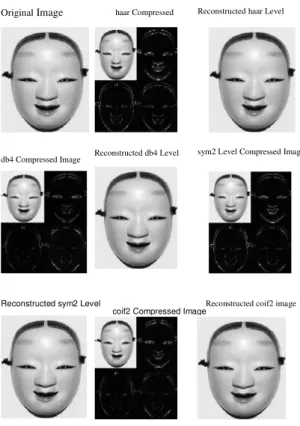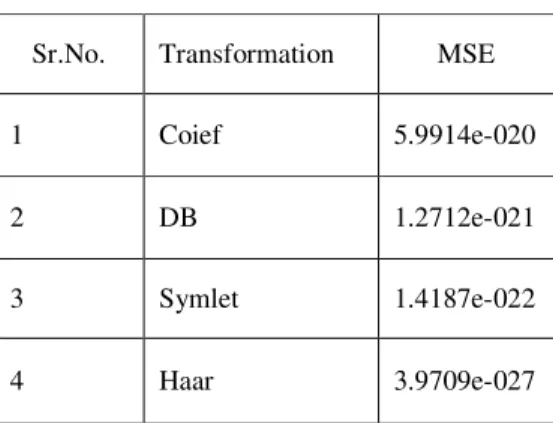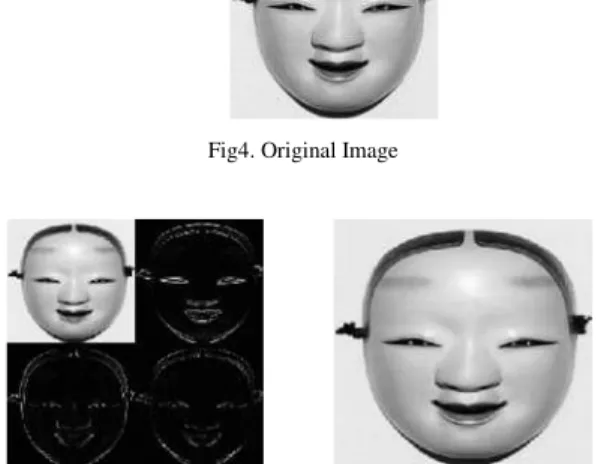An Algorithm for Image Compression
Using 2D Wavelet Transform
ROHIT ARORA
Department of Electronics and Communication Engineering, Punjab Technical University, Punjab Yamunanagar ,135001, India
MADAN LAL SHARMA
Department of Electronics and Communication Engineering, Punjab Technical University, Punjab Jalandhr(Sangrur),144601,India
NIDHIKA BIRLA
Department of Electronics Engineering, Kurukshetra University, H.E.C. Jagadhri,135003,India
ANJALI BALA
Department of Instrumentation & Control Engineering, Kurukshetra University, H.E.C. Jagadhri, Haryana, 135003, India
Abstract:-
Compressing an image is significantly different than compressing raw binary data. Of course, general purpose compression programs can be used to compress images, but the result is less than optimal. This is because images have certain statistical properties which can be exploited by encoders specifically designed for them. Also, some of the finer details in the image can be sacrificed for the sake of saving a little more bandwidth or storage space. This also means that lossy compression techniques can be used in this area. The discrete wavelet is essentially sub band–coding system and sub band coders have been quit successful in speech and image compression. In this paper the standard image MASK is analyzed using wavelet techniques for image compression. The transformations used for wavelet transformations are Haar, Symlet, Coiflet and db4. The results in terms of compression ratio and MSE show that the Haar transformation has the best performance. The Haar transform is then used to compress the image up to four levels. The reconstructed image after every level of compression is also shown. It is clear that DWT has potential application in compression problem and the use of Haar transformation for Wavelet Transformation provides the best results.
Keywords: Wavelet transforms, Image compression, Haar wavelet, Compression Ratio, MSE.
1. Preamble
Practical data sequences normally contain a substantial amount of redundancy. Redundancy in signals can appear in form of smoothness of the signal or in other words correlation between the neighboring signal values. A data sequence, which Embeds redundancy, can be presented more compactly if the redundancy is removed by means of a suitable transform. An appropriate transform should match the statistical characteristic of the data.
Applying the transform on the data results in less correlated transform coefficients, which can be encoded with fewer bits. A popular transform that has been used for years for compression of digital still images and image sequences, is the Discrete Cosine Transform (DCT). The DCT transform uses cosine functions of different frequencies for analysis and decorrelation of data. In the case of still images, after transforming the image from spatial domain to transform domain, the transform domain coefficients are quantized (a lossy step) and subsequently entropy encoded.
Wavelet based image compression introduces no blocky artifacts in the decompressed image. The decompressed image is much smoother and pleasant to eyes. Also, we can achieve much higher compression ratios much regardless of the amount of compression achieved. Another interesting feature of wavelet is that we can improve the quality of the image by adding detail information. This feature is attractive for what is known as progressive transmission of images. Another lossy compression scheme developed for image compression is the fractal base image compression scheme. However the fractal based image compression beginning to loss ground because it is very complex and time consuming. Moreover, the achievable compression ratio is not high enough as can be achieved by using wavelet. Wavelet can also be used for lossless image compression as well. This is possible by the use of what is known as integer wavelet transforms.
This paper studies the standard image MASK that is analyzed using wavelet techniques for image compression. The transformations used for wavelet transformations are Haar, Symlet, Coiflet and DB. The results are studied in terms of compression ratio and MSE.
2. Theoretical Frame Work
Wavelets are mathematical functions that satisfy a certain requirement (for instance a zero mean), and are used to represent data or other functions. In Wavelet Transform, dilations and translations of a mother wavelet are used to perform a spatial/frequency analysis on the input data. For spatial analysis, contracted versions of the mother wavelets are used. These contracted versions can be compared with high frequency basis functions in the Fourier based transforms. The relatively small support of the contracted wavelets makes them ideal for extracting local information like positioning discontinuities, edges and spikes in the data sequence, which makes them suitable for spatial analysis. Dilated versions of the mother wavelet, on the other hand, have relatively large supports (the length of the dilated mother wavelet). The larger support extracts information about the frequency behavior of data. Varying the dilation and translation of the mother wavelet, therefore, produces a customizable time/frequency analysis of the input signal.
Waveletsare a useful mathematical tool for hierarchically decomposing functions in ways that are both efficient and theoretically sound. Broadly speaking, the wavelet transform of a function consists of a coarse overall approximation together with detail coefficients that influence the function at various scales. The wavelet transform has a long history of successful applications in signal and image processing. Several recent studies have also demonstrated the effectiveness of the wavelet transform as a tool for approximate query processing over massive relational tables and continuous data streams.
Briefly, the idea is to apply wavelet transform to the input relation to obtain a compact data synopsis that comprises a select small collection of wavelet coefficients. The excellent energy compaction and de-correlation properties of the wavelet transform allow for concise and effective approximate representations that exploit the structure of the data. Furthermore, wavelet transforms can generally be computed in linear time, thus allowing for very efficient algorithms.
3. Types Of Wavelet Transform
Wavelet transform are of different types. Some of them are explained as below:
3.1 Haar Wavelet Transform
The first DWT was invented by the Hungarian mathematician Alfréd Haar. For an input represented by a list of 2n numbers, the Haar wavelet transform may be considered to simply pair up input values, storing the difference and passing the sum. This process is repeated recursively, pairing up the sums to provide the next scale: finally resulting in 2n − 1 differences and one final sum
(The Haar scaling function) Let be defined by
∅: ⟶
Define as
Define the vector space Vj as
= ∅ ! i=0,…,2j-1 (3) 3.2 Symlet Wavelet Transform
In symN, N is the order. Symlets are only near symmetric; consequently some authors do not call them symlets. More about symlets can be found in Image compression. By typing waveinfo('sym') at the MATLAB command prompt, and survey of the main properties of this family can be obtained.
3.3 Coiflet Wavelet Transform
Coiflets are discrete wavelets designed by Ingrid Daubechies, at the request of Ronald Coifman, to have scaling functions with vanishing moments. this looks like
Bk = ( − 1)kCN − 1 – k (4)
where k is the coefficient index, B is a wavelet coefficient and C a scaling function coefficient. N is the wavelet index.
3.4 Daubechies (db4)Wavelet transform
The Daubechies wavelets are a family of orthogonal wavelets defining a discrete wavelet transform and characterized by a maximal number of vanishing moments for some given support. With each wavelet type of this class, there is a scaling function (also called father wavelet) which generates an orthogonal multiresolution analysis.
ci=gos2i+g1s2i+1+g2s2i+1+g3s2i+1 (5) c[i]=g0s[2i]+g1s[2i+1]+g2s[2i+2]+g3s[2i+3] (6)
Each iteration in the wavelet transform step calculates a wavelet function value. The index i is incremented by two with each iteration, and wavelet function values are calculated
4. Results and Discussion
A common characteristic of most of the images is that their neighboring pixels are correlated. Therefore the most important task is to find a less correlated representation of image. The fundamental components of compression are reduction of redundancy and irrelevancy.The algorithm for image compression using Wavelet Transform uses averaging and differencing to form the wavelet and then we use the threshold technique to reduce the number of coefficients and hence is applied to get the compressed image. The Algorithm is implemented on MATLAB 7.0.
Fig 1 Compression of MASK image using different wavelet transform
The performance of different wavelet transforms can be premeditated in terms of MSE as shown in the Fig2.
Fig 2 Performance of different wavelet transformation between Transformation and MSE
The results obtained using different transformations and MSE are summed up in the Table 1.
1 1.5 2 2.5 3 3.5 4
0 1 2 3 4 5 6x 10
-20 MSE for different wavelet transformations
M
S
E
Transformations [Coief DB Symlet Haar]
Reconstructed sym2 Level
coif2 Compressed Image
Reconstructed coif2 image Reconstructed haar Level
Original Image haar Compressed
Table 1 Result of Transformations and MSE
Sr.No. Transformation MSE
1 Coief 5.9914e-020
2 DB 1.2712e-021
3 Symlet 1.4187e-022
4 Haar 3.9709e-027
The performance of different transformations used for compression with wavelet is studied in terms of Compression ratio as shown in the Fig 3.
Fig 3 Performance of different wavelet transformation between Transformation and Compression Ratio
The results acquired using different transformations and Compression Ratio are summed up in the Table 2.
Table 2. Results of Transformation & Compression Ratio
S.No. Transformation Compression Ratio
1 Coief 3.7049
2 DB 3.8189
3 Symlet 3.9382
4 Haar 4.0000
Fig 4 shows the original image and Fig 5 to Fig 8 shows the different level compression and reconstruction using HAAR wavelet transform as it has been find out from table 1 and 2 that HAAR Wavelet has the good compression ratio and MSE and hence gives the better results for the image compression.
Fig 5 shows the first level compressed image and image reconstructed from it.
1 1.5 2 2.5 3 3.5 4
3.7 3.75 3.8 3.85 3.9 3.95
4 Compression Ratio of Different Transformations
C
o
m
p
re
s
s
io
n
R
a
ti
o
Fig 6 shows the second level image compressed image and reconstructed from it.
Fig 7 shows the Third level image compressed image and reconstructed from it.
Fig 8 shows the Fourth level image compressed image and reconstructed from it
Original Image
Fig 7. Third level compressed andreconstructed image Fig 6. Second level compressed andreconstructed image
Nowadays image compression is being used in order to reduce the memory required to store the images. In this paper different wavelet transforms has been used to compress the image named as ”MASK” and reconstruct the original image with different levels. On the basis of compression ratio and MSE it has been find out that the best compression and reconstruction of the image can be done using HAAR wavelet transform.
References
[1] P Raviraj and M.Y. Sanavullah, “ The modified 2D-Haar Wavelet Transformation in image compression ” Middle East Journal of Scientific Research, Vol: 2 , Issue: 2,pp 73-78,ISSN 1990-9233,Apr-Jun, 2007
[2] Nai-Xiang Lian,Vitali Zagorodnov, and yap-Peng Tan,”Error inhomogeneity of wavelet image compression”2006 IEEE 1597-1600. ISSN 1522-4880
[3] G. K. Kharate, A. A. Ghatol and P.P. Rege,”Image Compression Using Wavelet Packet Tree”, ICGST-GVIP Journal, Volume Issue (7), July 2005
[4] Rudra Pratap, “ Getting Started with MATLAB” A quick introduction for Scientists and Engineers, Oxford, ISBN-0-19-515014-7, 2003
[5] Rafael C. Gonzalez and Richard E. Woods, “Digital Image Processing”, 2nd Edition, Pearson Education, ISBN-81-7808-629-8, 2002 [6] David F. Walnut, “Wavelet Analysis”, Birkhauser,2002, ISBN-0-8176-3962-4.
[7] Sonja Grgic, mislav Grgic, and Branka Zovko-cihlar, “Analysis of inage compression using Wavelets” IEEE Transaction on industrial electronics Vol:48,no.3, june 2001.
[8] Lihong Huang Herman,”Image Compression using the Haar wavelet transform”.plenum press.IJCSIS vol.9 No.1,ISSN 1947-5500 january 2001.
[9] Martin Vetterl,”Wavelets,Approximation and Compression”. IEEE Signal Processing Magazine,Research journal computer science full vol.9 No.11, 2001,IJCSIS ,pp 127-133


